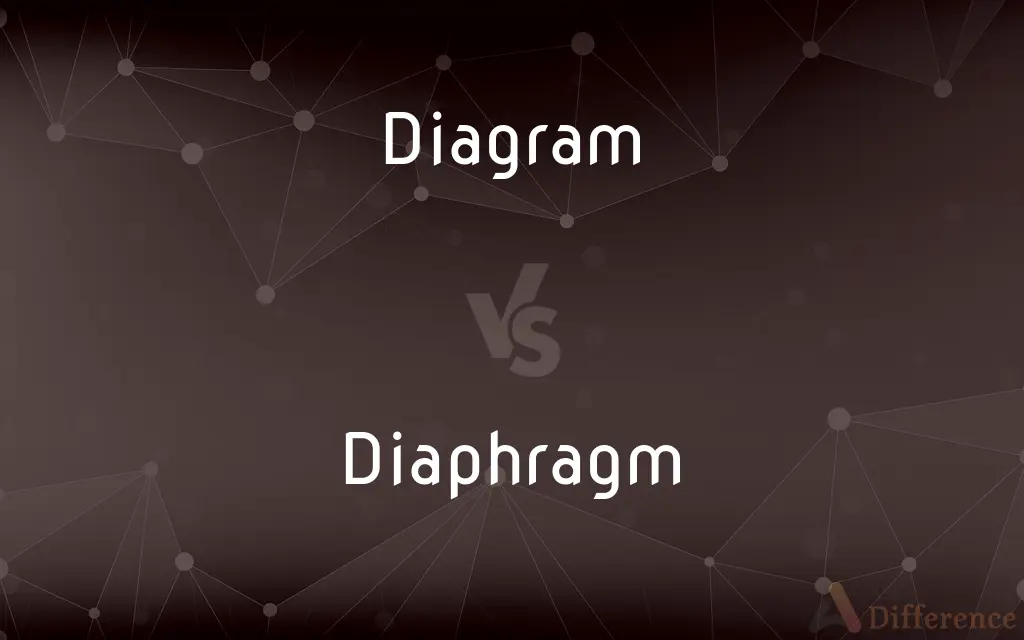Diagram vs. Diaphragm — What's the Difference?
By Tayyaba Rehman & Urooj Arif — Updated on April 27, 2024
A diagram is a visual representation of information, meant to simplify complex ideas, while a diaphragm is a muscular partition in the body, crucial for the respiratory process.

Difference Between Diagram and Diaphragm
Table of Contents
ADVERTISEMENT
Key Differences
A diagram is used to illustrate or explain concepts and relationships through symbols, lines, and graphics, facilitating understanding in educational and professional contexts. In contrast, a diaphragm is a physical structure located between the thoracic cavity and abdominal cavity, essential for breathing.
Diagrams can be created in various forms, such as flowcharts, schematics, or blueprints, each designed to serve specific purposes such as clarifying data flow or architectural layouts. Meanwhile, the diaphragm functions as a vital respiratory muscle that contracts and relaxes to help inflate and deflate the lungs.
The effectiveness of a diagram depends on its clarity and accuracy in conveying information. On the other hand, the health of the diaphragm is critical for proper lung function and overall respiratory health.
Diagrams are tools used across many disciplines, from engineering to biology, to help visualize complex systems and processes. Conversely, the diaphragm is studied primarily in fields like medicine and physiology as it relates to bodily functions and health.
The use of diagrams is integral in educational materials to aid in learning and comprehension, making complex topics more accessible. In contrast, understanding the function and mechanics of the diaphragm is crucial for medical professionals and students in health-related fields.
ADVERTISEMENT
Comparison Chart
Definition
A graphical representation
A muscular partition in the body
Primary Function
To illustrate or simplify information
To assist in the breathing process
Fields of Relevance
Education, engineering, management
Medicine, physiology
Types/Forms
Flowcharts, schematics, maps
Not applicable (one main type)
Impact or Importance
Enhances understanding and learning
Essential for respiratory health
Compare with Definitions
Diagram
A simplified drawing showing the appearance, structure, or workings of something.
The engineer drew a diagram to explain the machine's design.
Diaphragm
A dome-shaped muscular partition separating the thorax from the abdomen.
The diaphragm plays a crucial role in respiratory mechanics.
Diagram
A figure composed of lines to represent relationships.
He used a Venn diagram to illustrate the concept.
Diaphragm
A critical component of the respiratory system involved in gas exchange.
A healthy diaphragm ensures efficient lung function.
Diagram
A drawing intended to explain how something works.
The manual included a diagram for assembling the furniture.
Diaphragm
(Anatomy) A muscular membranous partition separating the abdominal and thoracic cavities and functioning in respiration. Also called midriff.
Diagram
A diagram is a symbolic representation of information using visualization techniques. Diagrams have been used since ancient times on walls of caves, but became more prevalent during the Enlightenment.
Diaphragm
A membranous part that divides or separates.
Diagram
A simplified drawing showing the appearance, structure, or workings of something; a schematic representation
A diagram of the living room
Diaphragm
The primary muscle used in the process of breathing, located below the lungs.
Deep breathing exercises strengthen the diaphragm.
Diagram
Represent (something) in graphic form
The experiment is diagrammed on page fourteen
Diaphragm
A muscle that contracts rhythmically with breathing.
Singers often train their diaphragm to improve vocal control.
Diagram
A graphical representation used to plan or discuss parts of a complex system.
The city's traffic flow was modeled with a detailed diagram.
Diaphragm
A thin disk, especially in a microphone or telephone receiver, that vibrates in response to sound waves to produce electric signals, or that vibrates in response to electric signals to produce sound waves.
Diagram
A plan, sketch, drawing, or outline designed to demonstrate or explain how something works or to clarify the relationship between the parts of a whole.
Diaphragm
A contraceptive device consisting of a thin flexible disk, usually made of rubber, that is designed to cover the uterine cervix to prevent the entry of sperm during sexual intercourse.
Diagram
(Mathematics) A graphic representation of an algebraic or geometric relationship.
Diaphragm
A disk having a fixed or variable opening used to restrict the amount of light traversing a lens or optical system.
Diagram
A chart or graph.
Diaphragm
(anatomy) In mammals, a sheet of muscle separating the thorax from the abdomen, contracted and relaxed in respiration to draw air into and expel air from the lungs; also called thoracic diaphragm.
Diagram
To indicate or represent by or as if by a diagram.
Diaphragm
(anatomy) Any of various membranes or sheets of muscle or ligament which separate one cavity from another.
Diagram
A plan, drawing, sketch or outline to show how something works, or show the relationships between the parts of a whole.
Electrical diagrams show device interconnections.
Diaphragm
A contraceptive device consisting of a flexible cup, used to cover the cervix during intercourse.
Diagram
A graph or chart.
Diaphragm
(mechanics) A flexible membrane separating two chambers and fixed around its periphery that distends into one or other chamber as the difference in the pressure in the chambers varies.
Diagram
(category theory) A functor from an index category to another category. The objects and morphisms of the index category need not have any internal substance, but rather merely outline the connective structure of at least some part of the diagram's codomain. If the index category is J and the codomain is C, then the diagram is said to be "of type J in C".
Diaphragm
(acoustics) In a speaker, the thin, semi-rigid membrane which vibrates to produce sound.
Diagram
(transitive) To represent or indicate something using a diagram.
Diaphragm
A thin opaque structure with a central aperture, used to limit the passage of light into a camera or similar device.
Diagram
(UK) To schedule the operations of a locomotive or train according to a diagram.
Diaphragm
(chemistry) A permeable or semipermeable membrane.
Diagram
A figure or drawing made to illustrate a statement, or facilitate a demonstration; a plan.
Diaphragm
(construction) A floor slab, metal wall panel, roof panel or the like, having a sufficiently large in-plane shear stiffness and sufficient strength to transmit horizontal forces to resisting systems.
Diagram
Any simple drawing made for mathematical or scientific purposes, or to assist a verbal explanation which refers to it; a mechanical drawing, as distinguished from an artistical one.
Diaphragm
To reduce lens aperture using an optical diaphragm.
Diagram
To put into the form of a diagram.
Diaphragm
To act as a diaphragm, for example by vibrating.
Diagram
A drawing intended to explain how something works; a drawing showing the relation between the parts
Diaphragm
A dividing membrane or thin partition, commonly with an opening through it.
Diagram
Make a schematic or technical drawing of that shows how things work or how they are constructed
Diaphragm
The muscular and tendinous partition separating the cavity of the chest from that of the abdomen; the midriff.
Diagram
A schematic representation or blueprint.
The architect presented the building diagrams during the meeting.
Diaphragm
A calcareous plate which divides the cavity of certain shells into two parts.
Diaphragm
A plate with an opening, which is generally circular, used in instruments to cut off marginal portions of a beam of light, as at the focus of a telescope.
Diaphragm
A partition in any compartment, for various purposes.
Diaphragm
A mechanical device in a camera that controls size of aperture of the lens;
The new cameras adjust the diaphragm automatically
Diaphragm
(anatomy) a muscular partition separating the abdominal and thoracic cavities; functions in respiration
Diaphragm
A contraceptive device consisting of a flexible dome-shaped cup made of rubber or plastic; it is filled with spermicide and fitted over the uterine cervix
Diaphragm
Electro-acoustic transducer that vibrates to receive or produce sound waves
Diaphragm
An anatomical barrier involved in several physiological functions besides breathing.
The diaphragm also helps in maintaining intra-abdominal pressure.
Common Curiosities
Can diagrams be used in digital formats?
Yes, diagrams are widely used in both digital and physical formats across various media and platforms.
What is the main use of a diagram?
Diagrams are primarily used to simplify and clarify complex information visually.
What exercises can strengthen the diaphragm?
Breathing exercises, like diaphragmatic breathing, can strengthen the diaphragm and improve lung capacity.
Is the diaphragm visible in medical imaging?
Yes, the diaphragm can be seen in medical imaging studies such as X-rays and MRIs.
Why is the diaphragm important for speech?
The diaphragm's role in controlling air flow is crucial for speech production, affecting voice modulation and breath control.
What can affect the functioning of the diaphragm?
Conditions like diaphragaphragmatic paralysis, hernias, or diseases like COPD can affect the functioning of the diaphragm.
How does the diaphragm contribute to breathing?
The diaphragm contracts to expand the lungs during inhalation and relaxes during exhalation, facilitating air flow.
Are there different types of diagrams?
Yes, diagrams include flowcharts, mind maps, schematics, and more, each suited for specific applications.
How do diagrams assist in learning?
Diagrams help by visually breaking down and organizing information, making it easier to understand and remember complex concepts.
Are diagrams important in scientific research?
Yes, diagrams are essential in scientific research for illustrating hypotheses, experimental setups, and data analysis.
How do professionals create complex diagrams?
Professionals use specialized software tools designed for creating detailed and accurate diagrams for various applications.
How does the diaphragm affect overall health?
Since the diaphragm is vital for breathing, its health directly impacts respiratory function and overall physical health.
Can a damaged diaphragm be repaired?
Yes, surgical interventions can repair or restore function to a damaged diaphragm.
What materials are best for teaching with diagrams?
Visual materials that clearly represent information with concise labeling and intuitive layouts are best for teaching with diagrams.
Share Your Discovery

Previous Comparison
Hound vs. Dog
Next Comparison
Millet vs. TeffAuthor Spotlight
Written by
Tayyaba RehmanTayyaba Rehman is a distinguished writer, currently serving as a primary contributor to askdifference.com. As a researcher in semantics and etymology, Tayyaba's passion for the complexity of languages and their distinctions has found a perfect home on the platform. Tayyaba delves into the intricacies of language, distinguishing between commonly confused words and phrases, thereby providing clarity for readers worldwide.
Co-written by
Urooj ArifUrooj is a skilled content writer at Ask Difference, known for her exceptional ability to simplify complex topics into engaging and informative content. With a passion for research and a flair for clear, concise writing, she consistently delivers articles that resonate with our diverse audience.














































